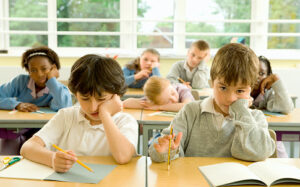 It is undeniable that being literate is one of the most important things a person needs to achieve in order to have a normal existence. From everyday things such as reading food labels, medication information, or household bills to more complex tasks such as reading and comprehending books and more difficult texts, reading enables a person to lead an independent and, hopefully, fulfilling life.
It is undeniable that being literate is one of the most important things a person needs to achieve in order to have a normal existence. From everyday things such as reading food labels, medication information, or household bills to more complex tasks such as reading and comprehending books and more difficult texts, reading enables a person to lead an independent and, hopefully, fulfilling life.
 The US Department of Education and National Center for Education Statistics differentiate between three types of literacy, “Prose literacy is the knowledge and skills needed to perform prose tasks (i.e., to search, comprehend, and use information from continuous texts, such as paragraphs from stories); document literacy is the knowledge and skills needed to perform document tasks (i.e., to search, comprehend, and use information from non-continuous texts in various formats, such as bills or prescription labels); and quantitative literacy is the knowledge and skills required to perform quantitative tasks (i.e., to identify and perform computations, either alone or sequentially, using numbers embedded in printed materials).” As such, according to their statistics dating from 2003, 22 percent of adults (those who are 16 or older) in the USA perform below basic in quantitative literacy, 14 percent of adults are below basic in prose literacy, and 12 percent in document literacy.
The US Department of Education and National Center for Education Statistics differentiate between three types of literacy, “Prose literacy is the knowledge and skills needed to perform prose tasks (i.e., to search, comprehend, and use information from continuous texts, such as paragraphs from stories); document literacy is the knowledge and skills needed to perform document tasks (i.e., to search, comprehend, and use information from non-continuous texts in various formats, such as bills or prescription labels); and quantitative literacy is the knowledge and skills required to perform quantitative tasks (i.e., to identify and perform computations, either alone or sequentially, using numbers embedded in printed materials).” As such, according to their statistics dating from 2003, 22 percent of adults (those who are 16 or older) in the USA perform below basic in quantitative literacy, 14 percent of adults are below basic in prose literacy, and 12 percent in document literacy.
 The consequences of being illiterate or functionally illiterate are overwhelming. There is a very high correlation between illiteracy and poverty, possible imprisonment, teenage pregnancy, dropping out of high school, and unemployment. For example, proliteracy.org provides the following numbers: 43 % of those who are at low literacy level live in poverty, 75 percent of state prison inmates and 59 percent of federal prison inmates are functionally illiterate, teenage girls at low literacy are four times more likely to become pregnant, $230 billion are added to government budget in health costs because of low literacy, and $ 225 billion are lost annually due to unemployment and lost taxes because of people at low literacy level.
The consequences of being illiterate or functionally illiterate are overwhelming. There is a very high correlation between illiteracy and poverty, possible imprisonment, teenage pregnancy, dropping out of high school, and unemployment. For example, proliteracy.org provides the following numbers: 43 % of those who are at low literacy level live in poverty, 75 percent of state prison inmates and 59 percent of federal prison inmates are functionally illiterate, teenage girls at low literacy are four times more likely to become pregnant, $230 billion are added to government budget in health costs because of low literacy, and $ 225 billion are lost annually due to unemployment and lost taxes because of people at low literacy level.
How does the USA compare to other world countries? Total world illiterate population constitutes 16 percent with women being two-thirds of those. There are three major regions in the world with the lowest literacy scores: Sub-Saharan Africa, South Asia, and West Asia. However, according to 2011 statistics, the USA was the only free-market OECD (Organization for Economic Cooperation and Development) country where current generation was less well-educated than the previous one. Based on US literacy levels, the USA is outperformed by such countries as Norway, Sweden, Finland, Switzerland, Canada and many others.
 In modern world where access to information, education, and knowledge determines future success of any person, illiteracy is simply not an option. Therefore, it is truly disturbing that a country with such potential and wealth as the USA still fails to provide decent level of education for many people. Not only education budgets are routinely cut across the states, but higher education is also becoming more and more prohibitive money-wise for those who want to pursue college education. It would be highly advisable to learn from the countries which excel at providing education for their populations.
In modern world where access to information, education, and knowledge determines future success of any person, illiteracy is simply not an option. Therefore, it is truly disturbing that a country with such potential and wealth as the USA still fails to provide decent level of education for many people. Not only education budgets are routinely cut across the states, but higher education is also becoming more and more prohibitive money-wise for those who want to pursue college education. It would be highly advisable to learn from the countries which excel at providing education for their populations.


